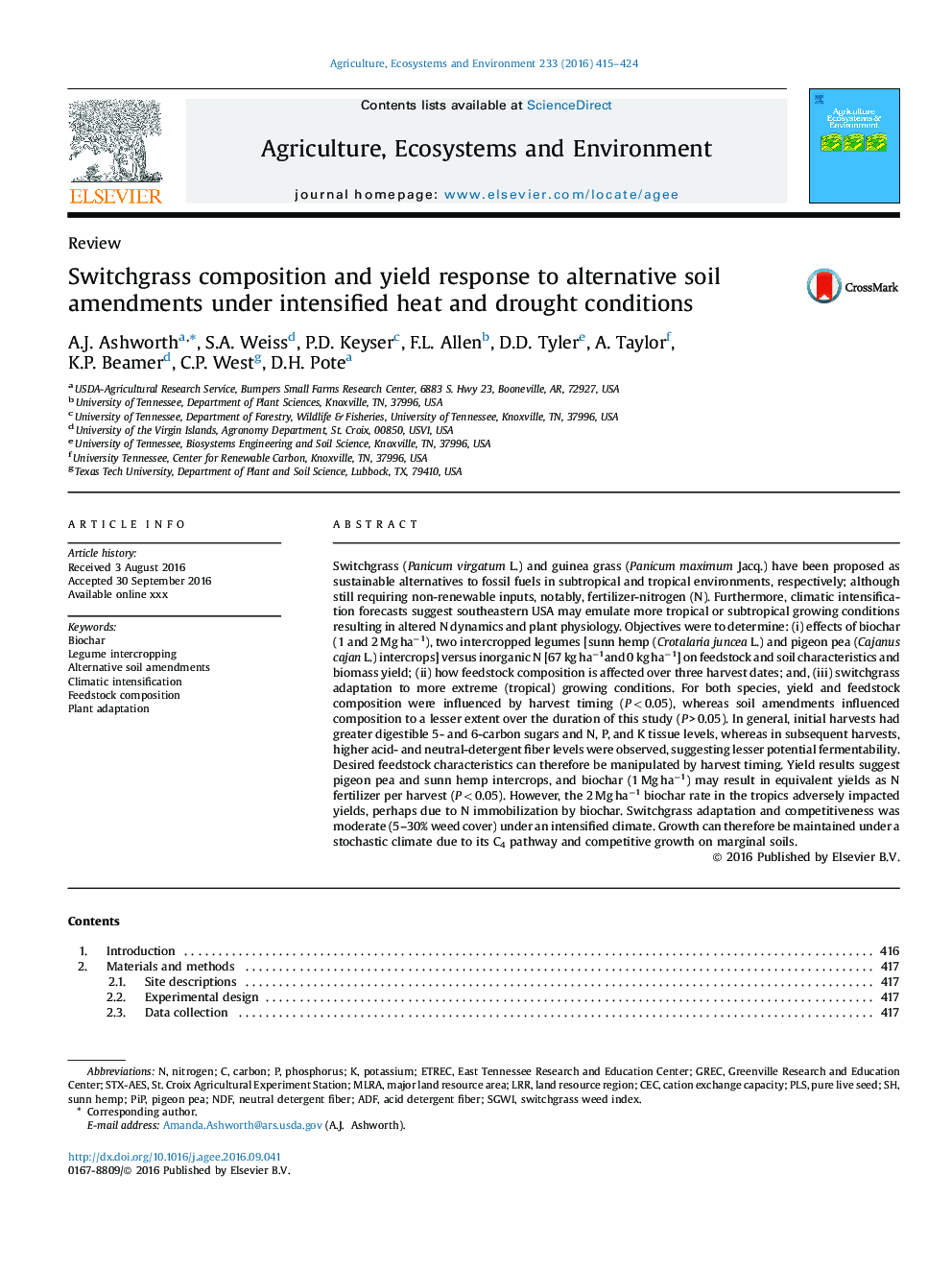| کد مقاله | کد نشریه | سال انتشار | مقاله انگلیسی | نسخه تمام متن |
|---|---|---|---|---|
| 8487295 | 1552019 | 2016 | 10 صفحه PDF | دانلود رایگان |
عنوان انگلیسی مقاله ISI
Switchgrass composition and yield response to alternative soil amendments under intensified heat and drought conditions
ترجمه فارسی عنوان
ترکیب و پاسخ عملکرد به اصلاح خاک جایگزین در شرایط شدت گرما و خشکی
دانلود مقاله + سفارش ترجمه
دانلود مقاله ISI انگلیسی
رایگان برای ایرانیان
کلمات کلیدی
ADFPLSMLRANDFLRRCECacid detergent fiber - الیاف پاک کننده اسیدBiochar - بیوچار Feedstock composition - ترکیب مواد اولیهplant adaptation - سازگاری با گیاهcation exchange capacity - ظرفیت تبادل کاتیونPhosphorus - فسفرneutral detergent fiber - فیبر مواد شوینده خنثیPigeon pea - نخود کبوترNitrogen - نیتروژنPotassium - پتاسیمsunn hemp - پیراهن سالمPiP - پیپCarbon - کربن
موضوعات مرتبط
علوم زیستی و بیوفناوری
علوم کشاورزی و بیولوژیک
علوم زراعت و اصلاح نباتات
چکیده انگلیسی
Switchgrass (Panicum virgatum L.) and guinea grass (Panicum maximum Jacq.) have been proposed as sustainable alternatives to fossil fuels in subtropical and tropical environments, respectively; although still requiring non-renewable inputs, notably, fertilizer-nitrogen (N). Furthermore, climatic intensification forecasts suggest southeastern USA may emulate more tropical or subtropical growing conditions resulting in altered N dynamics and plant physiology. Objectives were to determine: (i) effects of biochar (1 and 2 Mg haâ1), two intercropped legumes [sunn hemp (Crotalaria juncea L.) and pigeon pea (Cajanus cajan L.) intercrops] versus inorganic N [67 kg haâ1and 0 kg haâ1] on feedstock and soil characteristics and biomass yield; (ii) how feedstock composition is affected over three harvest dates; and, (iii) switchgrass adaptation to more extreme (tropical) growing conditions. For both species, yield and feedstock composition were influenced by harvest timing (P < 0.05), whereas soil amendments influenced composition to a lesser extent over the duration of this study (P > 0.05). In general, initial harvests had greater digestible 5- and 6-carbon sugars and N, P, and K tissue levels, whereas in subsequent harvests, higher acid- and neutral-detergent fiber levels were observed, suggesting lesser potential fermentability. Desired feedstock characteristics can therefore be manipulated by harvest timing. Yield results suggest pigeon pea and sunn hemp intercrops, and biochar (1 Mg haâ1) may result in equivalent yields as N fertilizer per harvest (P < 0.05). However, the 2 Mg haâ1 biochar rate in the tropics adversely impacted yields, perhaps due to N immobilization by biochar. Switchgrass adaptation and competitiveness was moderate (5-30% weed cover) under an intensified climate. Growth can therefore be maintained under a stochastic climate due to its C4 pathway and competitive growth on marginal soils.
ناشر
Database: Elsevier - ScienceDirect (ساینس دایرکت)
Journal: Agriculture, Ecosystems & Environment - Volume 233, 3 October 2016, Pages 415-424
Journal: Agriculture, Ecosystems & Environment - Volume 233, 3 October 2016, Pages 415-424
نویسندگان
A.J. Ashworth, S.A. Weiss, P.D. Keyser, F.L. Allen, D.D. Tyler, A. Taylor, K.P. Beamer, C.P. West, D.H. Pote,
